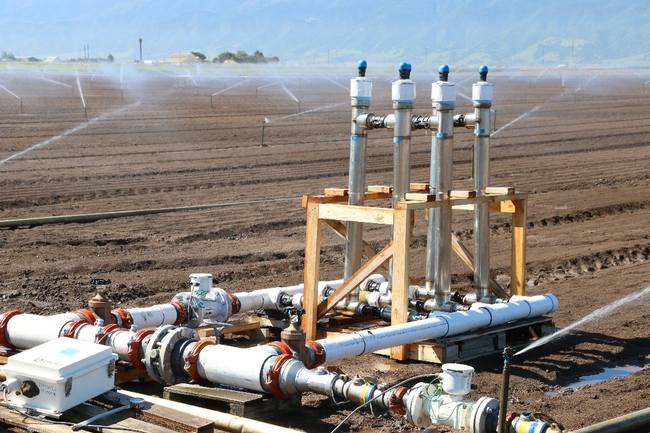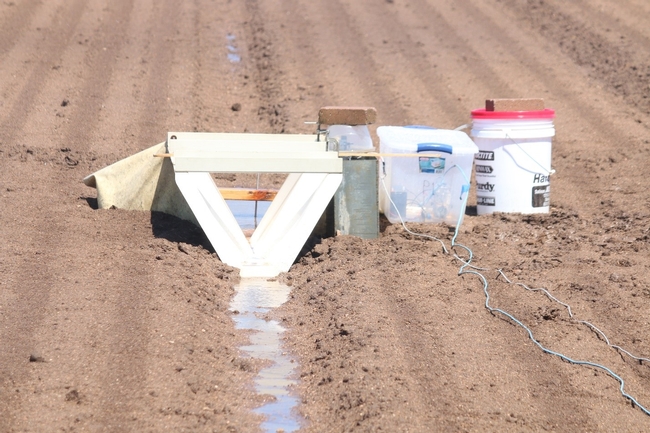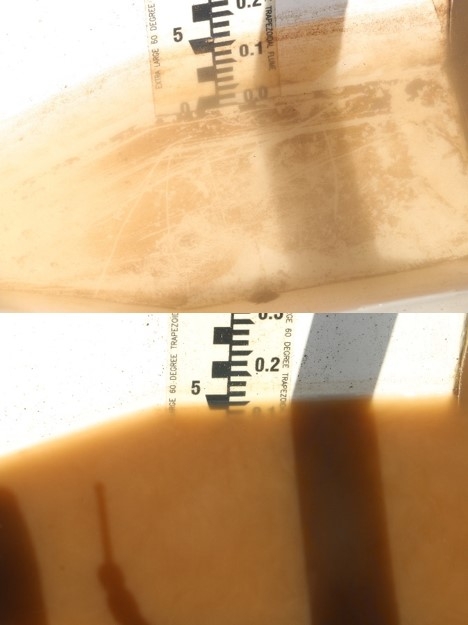Background
Pyrethroid pesticides strongly bind to suspended sediments carried in agricultural runoff and have been identified as a source of aquatic toxicity on the central coast by both the Central Coast Regional Water Quality Control Board and the California Department of Pesticide Regulation. Sprinkler irrigation of vegetable crops often results in significant volumes of runoff, especially during the germination and stand establishment phase. Unless growers can contain agricultural runoff on their ranches, mitigation practices are needed to minimize downstream water quality impacts.
Polyacrylamide has been shown to minimize erosion in furrow irrigated fields. Several field studies that we conducted more than 10 years ago also demonstrated that long chained anionic polyacrylamides can be used in pressurized sprinkler systems to minimize sediment losses from vegetable fields. These studies concluded that maintaining a concentration of 2.5 to 5 ppm PAM in the water during an irrigation can reduce sediment concentrations in run-off by more than 90%. These studies showed that the best method for injecting PAM into pressurized irrigation systems was to use a liquid formulation and a specialized metering pump developed for viscous liquids. Although the pump was relatively easy to use, it was expensive ($3500 per pump) and required that irrigators received training on how to operate the pump and correctly dose the irrigation water. In addition, the liquid formulation of PAM, which was emulsified with mineral oil, was more than twice the cost of dry granular formulations ($4/lb vs. $2/lb). The total cost for treating with PAM was estimated at $26 to $34/acre using the liquid formulation for four irrigations (Cahn 2006).
Another issue identified for liquid formulations of PAM was potential aquatic toxicity. Although research studies have shown that anionic PAM is not toxic to aquatic organisms, the mineral oil use to emulsify liquid PAM products was shown to have toxicity to Ceriodaphnia dubia and Hyalella azteca, both of which are test organisms used to evaluate aquatic toxicity. Although other liquid formulations of PAM using humectant ingredients were shown to be non-toxic to aquatic organisms and effective in controlling sediment (Cahn and Farrara 2009), they were more expensive and less widely available than the mineral oil-based formulations.
The solid tablet and granular forms of PAM are easier to handle than liquid formulations and cheaper but dissolving these forms of PAM at a rate sufficient to provide an efficacious concentration in a pressurized irrigation system is challenging. Rather than dissolving uniformly into solution tablet and granular forms of PAM tend to form clumps when added to water and require prolonged agitation to dissolve uniformly.
A new type of PAM applicator
During the past two years we designed, and field tested several prototype applicators that can add dry forms of PAM (tablet or granular) at a low but consistent rate in pressurized irrigation systems.After several modifications we settled on a design that maximized the efficiency of dissolving dry forms of PAM into flowing pressurized irrigation water. The current applicator consists of cartridges filled with PAM that insert into a series of six stainless steel cylindrical chambers (Fig. 1). A portion of the irrigation water can be diverted into the inlet of the applicator by partially closing a valve on the mainline or using a small pump on the inlet side. The diverted water passes through three pairs of chambers and then returns into the mainline. The dry PAM forms a viscous gel on the surface of the cartridge when exposed to water. The PAM dissolves into solution as the water streams through the gap between the cartridges and the outer wall of the chambers. Static mixers that fit around the cartridges force water to swirl around in the chamber, improving the dissolution of PAM (Fig. 2). The PAM applicator shown here was built by Ray Fab Inc. in Salinas, CA.
Field testing of the PAM applicator
Field testing of the final version of the PAM applicator was done in two commercial lettuce fields on the east-side of the Salinas Valley, north of Chualar CA. Testing was done during the germination phase of the crop using overhead sprinklers during April and May of 2020. The soil types were Chualar loam and Placentia sandy loam for trial 1 and Chualar loam for trial 2 fields. Lettuce crops were seeded in 6 rows on 80-inch wide beds on April 14 for trial 1 and May 7, 2020 for trial 2. The PAM used for testing was Soilfloc 100D, an anionic linear PAM developed for soil erosion control and manufactured by Hydrosorb Inc. The PAM applicator was positioned in the field next to the mainline (Fig. 1). Flowmeters were used to measure the flow rate in the mainline and at the inlet of the applicator. Another flowmeter monitored the volume of water applied to the adjacent untreated plot. The PAM treated plots measured 1.9 acres in trial 1 and 3.4 acres in trial 2. The flow rate of water applied to the PAM treated plot ranged from 235 to 260 gpm for trial 1 and 440 to 480 gpm for trial 2 (resulting in an average application rate of about 0.3 inches per hour). A portion of the irrigation water (160 to 190 gpm, or about 40% to 70% of the flow) was diverted from the mainline through the applicator and returned back to the mainline. Total water applied during the six irrigation events was approximately 4.7 and 6 inches for trials 1 and 2, respectively. Flumes were positioned 30 feet from the lower end of the field to measure run-off volume from 4 furrows in the PAM and untreated plots (Fig. 3). The flumes were equipped with a float mechanism calibrated to measure the height of water in the flume. A data logger recorded the height of the float mechanism which was transformed using the manufacturers' calibration curve to estimate the flow rate of the run-off. The dataloggers also automated sampling of the run-off into a container using a peristaltic pump. Composite samples of run-off were collected from the plots after each of six irrigation events and analyzed for turbidity, and concentration of suspended sediments, total N, nitrate-N, and orthophosphate.
Figure 1. Prototype PAM applicator in a sprinkler irrigated lettuce field.
Figure 2. PAM cartridge with static mixing element. Note that after exposure to water the dry PAM becomes a viscous gel that coats the surface of the cartridge.
Figure 3. Flume and peristaltic pumping system used to monitor run-off volume and automatically collect run-off samples from test plots in a commercial lettuce field.
Field testing of the PAM applicator demonstrated an average reduction in turbidity of 92% (Fig 4.) and an 86% reduction in total suspended solids (suspended sediments) in sprinkler run-off for the two trials (Table 1). The turbidity and concentration of suspended sediments increased with each irrigation in the untreated plot but remained low in the PAM treated plots. In addition to reducing turbidity and suspended sediment concentration, the PAM application reduced the volume of runoff. Total run-off volume from the PAM treated plot was 17% less than the untreated plot in trial 1 and 69% less in trial 2 (Table 2), indicating that a greater portion of the applied water infiltrated into the soil with the PAM treatment. The different effect of PAM on runoff volume measured for the two trials may be a result of several factors such as differences in soil texture, slope, field length, land preparation, irrigation frequency, etc. Nevertheless, the combined effect of PAM on runoff volume and suspended sediment concentration resulted in a large reduction in sediment loss from treated plots for both field trials. Total sediment loss after six consecutive irrigations was 66.3 lbs/acre in the untreated plot and 7.5 lbs/acre in the PAM treated plot (89% reduction) for trial 1 and 72.9 lbs/acre in the untreated plot compared with 2.7 lbs/acre in the PAM treated area for trial 2 (96% reduction). Concentration of nitrogen and phosphorus in run-off from the PAM treated plot were not reduced relative to the untreated plot (data not presented).
Figure 4. Sprinkler run-off from PAM treated (top) and untreated (bottom) plots in a commercial romaine lettuce field. Run-off is flowing through flumes positioned at the lower end of the plots.
Table 1. Average turbidity and total suspended solids in runoff from six irrigations collected from PAM and untreated plots.
Table 2. Cumulative runoff volume and sediment loss after six irrigations in PAM and untreated plots.
Because only a few specialized laboratories can measure PAM concentration we estimated the concentration in the treated irrigation water by evaluating the remaining quantity of PAM in the applicator cartridges after trial 1 was completed. We observed that about 90% of the initial volume of PAM remained, which would suggest that no more than 1 lb of PAM per acre was applied to the field during the six irrigation events. This amount would correspond to treating the irrigation water with 0.5 to 1 ppm of PAM.
Conclusions
Field testing of our prototype applicator demonstrated a simple and effective method to use polyacrylamide (PAM) to mitigate sediment losses from vegetable fields irrigated with overhead sprinklers. Our results showed both a reduction in sediment concentration in runoff as well as an improvement in water infiltration which would both conserve water and minimize the volume of runoff. The scope of this study did not include measurement of pesticide reductions but since pyrethroid pesticides, such as permethrin, strongly bind to sediment, minimizing suspended sediments in the runoff would presumably reduce pesticide loads and downstream water quality impacts. Although the applicator was set up in the field during these tests, the design could also be scaled up to accommodate greater volumes of water and be located at the well, much like a filter station. Further testing will continue during the upcoming season to evaluate the number of PAM cartridges required to optimize treatment at flow rates greater than 500 gpm, which would be more typical of wells in the Salinas Valley. If you have interest to test the PAM applicator in your field or learn more about how to use polyacrylamide (PAM) for mitigating sediment in runoff, please contact us and we may be able to arrange a demonstration or field test.
Past articles on polyacrylamide
Cahn M. (2005) Using polyacrylamide (PAM) for reducing sediment and nutrient losses. Conservation Currents. March 2005
Cahn M., Ajwa H., Smith R. (2004b) Evaluation of polyacrylamide (PAM) for reducing sediment and nutrient concentration of tailwater from central coast vegetable fields 12th Annual Fertilizer Research and Education Program Conference November 20, 2004 2004 Tulare, CA 17-22
Cahn, M. Qin, Z., Chambers, D. (2019) Mitigating pesticides and sediment in tail water using polyacrylamide (PAM). Progressive Crop Consultant. July/August 2019 p. 4-8.
Weston D., Lentz R., Cahn M., Ogle R., Rothert A., Lydy M. (2009) Toxicity of anionic polyacrylamide formulations when used for erosion control in agriculture. Journal of Environmental Quality 38
Acknowledgments
We thank the California Leafy Greens Research Board for financial support of this project and assistance of Mike Ray of Ray Fab Inc. for construction of the PAM applicator.





